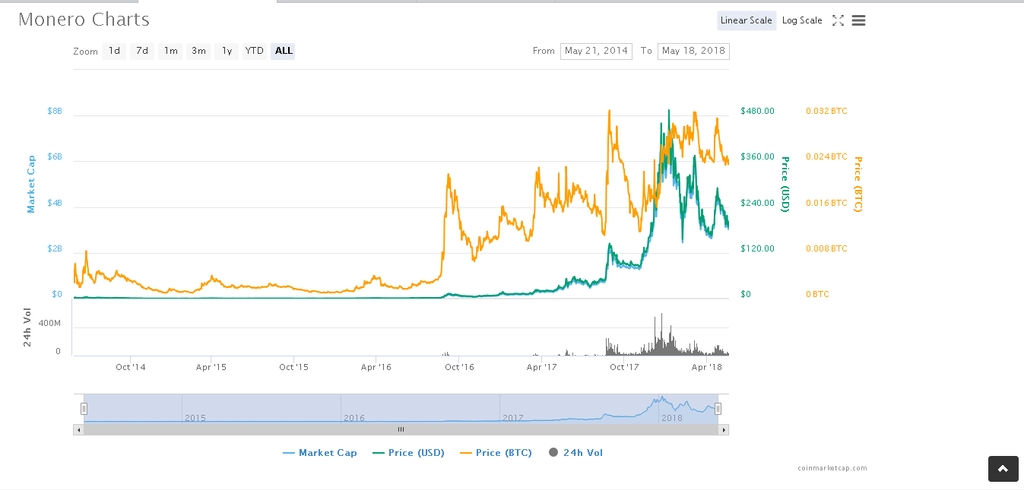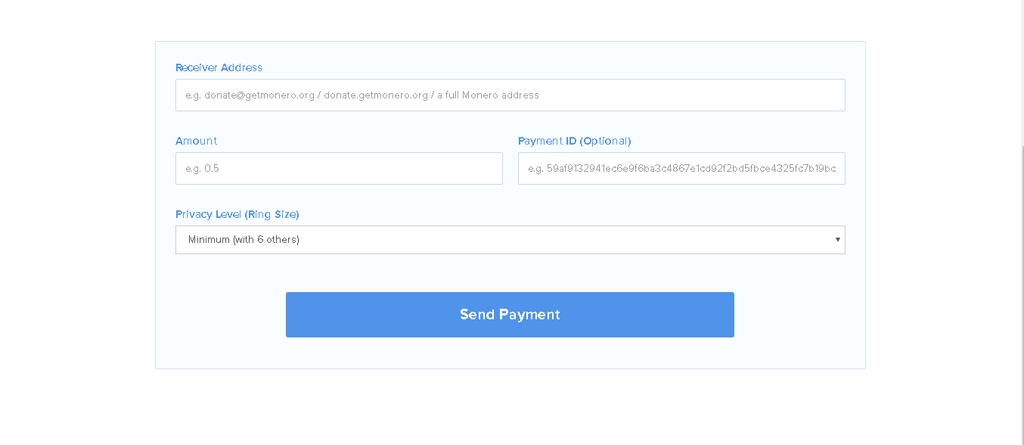
Free Airdrop Season 7 is LIVE! Answer fun questions or do simple tasks to earn rewards from the $30K BitDegree prize pool. Participate Now ! 🔥
Did you know that Monero is considered to be the most popular privacy-focused cryptocurrency on the planet? You’ve probably heard of Bitcoin and Ethereum by now, but there are literally thousands of other coins, and each of them claim to offer different improvements on Bitcoin.
Some have cheaper transactions, some are faster. However, Monero’s (almost) unique selling point is that it is completely anonymous.
That’s right! Thanks to some pretty high-tech cryptography, the sender, receiver, and the amount of Monero sent is impossible to view by anyone else.
For this reason, Monero has found a unique use in evading international sanctions by the likes of North Korea, or as a means of payment on the Dark Web. However, there are also some great reasons for having a private form of money that are not illegal. I’ll explain a few of these later.

Hopefully, this “what is Monero” guide will introduce you to Monero in a way that is easy to understand. Unfortunately, the topic is a rather confusing one, and to fully grasp all Monero’s features, you’d need a strong understanding of cryptography. Since this is an article aimed at beginners, we’ll not spend too much time on these because I don’t want to confuse you!
By the end of this guide, you should have a clear understanding of Monero’s history, some idea of how its privacy features work, how it differs from Bitcoin, the current Monero value how to set up a wallet in the easiest way possible (and how to buy Monero), and the advantages and disadvantages of Monero. Before concluding, I’ll also introduce some ideas about Monero’s future for you to think about.
Before all that though, we need to go all the way back to before Monero even existed!
Looking for the most secure place to buy BTC? I have collected the best-rated crypto exchanges that were approved as the safest platforms for buying BTC below, so take a look.
Pros
- One of the most privacy-oriented cryptocurrencies
- Very scalable
- Transactions cannot be linked back to you
- Respected in the crypto world
Cons
- A bit difficult to deal with (storage, etc.)
- Many wallets do not support Monero
Table of Contents
- 1. The History of Monero
- 2. What Makes Monero Different?
- 2.1. Privacy
- 2.2. Fungibility
- 2.3. Dynamic Scalability
- 2.4. ASIC Resistance
- 2.5. Multiple Keys
- 3. Monero and it's Eventual Supply
- 4. Monero and the Wider Cryptocurrency Market
- 5. How to Store Monero
- 5.1. Storing XMR
- 5.2. Sending XMR
- 6. The Advantages and Disadvantages of Monero
- 7. Monero In The Future
- 8. Conclusions
The History of Monero
To trace the origins of Monero, we need to look at a different cryptocurrency – Bytecoin.
Bytecoin was launched in the summer of 2012. It was the first digital currency that was written using a technology called CryptoNote.
CryptoNote today is the backbone of most of the privacy-based cryptocurrencies that exist. This includes Monero. The privacy of CryptoNote coins is ensured by grouping public keys together. By combining several keys in a single transaction, it's impossible to tell who sent it!
The use of these “ring signatures” to sign transactions provides the anonymity of the CryptoNote technology.
Bytecoin was a good effort at an anonymous cryptocurrency. However, there were a few issues with its initial distribution. When it launched, it turned out that 80% of the coins that would ever be mined were already in existence.

This lead a group of seven developers to fork the Bytecoin blockchain and the new currency would be known as Bitmonero. This was eventually shortened to simply Monero which is Esperanto for "coin".
Of the seven developers who originally created Monero, five of them decided that they would keep their identities secret. Only two of these Monero developers are known about - Riccardo Spagni (the main developer today) and David Latapie. Riccardo Spagni is also known by the nickname "Fluffypony".
What Makes Monero Different?
There is a lot about Monero that is similar to many other cryptocurrencies. It's an open-source project that is entirely permission-less. This second feature is potentially world-changing. There is no authority that can stop you from using a cryptocurrency.

This means that those without access to modern banking facilities can take part in a digital economy in the way they never could before. All they need is an internet connection and a device to connect to it. There are literally millions of people around the world that lack access to banking facilities but have smartphones and local Wi-Fi hotspots. India is a prime example of a country with many of these "unbanked" citizens.
Privacy
The main thing that gives Monero value is its privacy features. No one can link you to a Monero cryptocurrency transaction. This makes it a favorite currency for those who are concerned with privacy for a variety of reasons. Not all these reasons will be illegal, although some obviously will be.
Imagine that you were a homosexual living with a very religious family. It might be difficult for you to meet people in a similar position as you. Whilst certainly not illegal, the stigma attached to being gay in certain religious groups could drive a young person to depression, or worse. A currency like Monero could be used to pay for social or "matchmaker" type applications. In such a situation, privacy is a necessity even though no law is being broken.
There are also instances that a law might be being broken, but it's such an unjust one, that an otherwise law-abiding citizen is driven to so-called criminality. I'll use another made up, but believable example to show this. Imagine you and your partner just had a child together. When your baby was born, they had severe epilepsy.

After putting your child through a hellish schedule of traditional medicine – many pills several times a day, you saw a news report about medicinal cannabis. A family in the same situation as you are living across an imaginary line on a map were legally allowed to give their child strong doses of cannabis extracts. This seemed to instantly cure the epileptic seizures in the infant.
It seems wrong to be denied access to such a medicine, based on the location that you were born. Monero could help you in such situations, too.
Fungibility
Another very important feature of the Monero cryptocurrency that relates to its privacy is that it is entirely fungible. Don't worry, I'll explain what I mean by this!
It's possible to track Bitcoin transactions from one user to another. Depending on how the user uses Bitcoin, you might not be able to tell their identity, but you can follow each Bitcoin from address to address.
This means that a user can tell if a certain Bitcoin was involved in a crime. This isn't an ideal quality for the money!

Let's look at an example to prove this. Say you sold a completely legal item on a platform like Open Bazaar, and you received Bitcoin as a payment. However, it turns out that the Bitcoin you received was previously used in a drug deal. For you, that might not be an issue. However, when you try to spend it somewhere else, the person receiving it could decide that they don't want this "tainted" coin.
Thanks to the advanced privacy features of Monero, no one can tell which transactions each coin was actually involved in. It would be entirely impossible to link a single Monero coin to a past crime. There is no transaction history associated with any Monero coins. This means they are fungible!
I am inundated by people asking me for recommendations on cryptocurrencies. If you would use your heads you would figure out that the privacy coins (anonymous transactions) will have the greatest future. Coins like Monero (XMR), Verge (XVG), or Zcash (ZEC) cannot lose.Fluffypony
— John McAfee (@officialmcafee) December 13, 2017
Sign up on Binance and claim up to $600 worth of rewards for completing simple tasks. Use Binance referral code (49316610) to activate the offer while it's still valid!
Dynamic Scalability
Another area that Monero tried to improve on Bitcoin is in terms of its scalability. Put simply, scalability just means how well the network can grow in relation to demand. Blockchain-based cryptocurrencies are by definition limited in size.
For much of its past, Bitcoin has had a 1MB block-size limit. This means that only 1MB of transaction data can fit into each of the blocks that are mined every 10 minutes on the Bitcoin network.
Unfortunately, when there are many users trying to make transactions at the same time using Bitcoin, the blockchain gets filled with transaction data. Those transactions that can't fit into a block must wait for a miner to include them.
Since miners prefer to include transactions with the largest fees attached, if the network is very busy, it encourages people to increase the fees to get their transactions included. This is what happened in the Spring of 2017 to the Bitcoin blockchain. Some transactions were actually requiring a $30+ fee just to be validated!

Monero is different. There is no "pre-set" block size limit. Whilst this does allow for more transaction data in each block, there is a downside – spammers can fill the blockchain was transactions. This would make huge blocks.
However, the Monero developers introduced a block reward-penalty system. The median size of the last 100 blocks is taken. If the new block that the miners are working on exceeds the median of the previous hundred blocks, the block reward is reduced. This discourages spam transactions, since miners won’t mine blocks that are subject to such a large penalty if it’s no longer profitable for them to do so.
The block reward will never drop below 0.3 XMR, making Monero a disinflationary currency: the inflation will be roughly 1% in 2023 and go down forever, but the nominal inflation will stay at 0.3 XMR per minute. This means that there will always be an incentive for miners to mine Monero and thus keeping the blockchain secure, with or without a fee market.
Monero
ASIC Resistance
Another perceived issue with Bitcoin is that mining the network is now only profitable using specialized mining equipment. These systems use components known as Application Specific Integrated Circuit chips. They’re expensive and this means that only the richest can set up mining operations.
Monero differs. It uses an alternate hashing algorithm to Bitcoin called CryptoNight. CryptoNight uses a lot of advanced features to make the production of ASIC chips suitable for mining Monero unprofitable.
The specifics are a little complex for this introduction to the Monero currency but all you really need to know is that Monero can be profitably mined using both CPUs and GPUs. This should mean that the currency has the potential to be even more decentralized than Bitcoin.
Multiple Keys
Monero uses a different system of keys to the likes of Bitcoin and Ethereum. In these currencies, there is just one pair of keys – a public key and a private key. Monero uses a public view key, a private view key, and both public and private spend key.
- Only stealth public addresses are used, and only public view keys are generated..
- For checking the blockchain and verifying that funds have been received, a private view key is needed.
- To verify the signature on a transaction requires a public spend key.
- Private spend keys are used to create outgoing transactions.

Did you know?
All Crypto Exchanges may look similar to you but they're NOT all the same!
Monero and it's Eventual Supply
Unlike Bitcoin, there isn’t a fixed number of Monero tokens that will ever be mined. The currency is ever-so-slightly inflationary. There will initially be 18.5 million coins, following this the supply will increase by around 0.87% in the first year.
This percentage lowers each year. It’s estimated that it will take 117 years to reach double the initial distribution. For this figure to double again, it will take 234 years.
Monero and the Wider Cryptocurrency Market
The current price for a single XMR coin is $101.25. The currency is the 12th most popular in terms of total market capitalization.
Below, I’ve included the graph of the Monero coin’s performance since it was launched. As you can see, like most cryptocurrencies, the value spiked around January 2018 and has fallen back quite a bit since its all-time high of $480.

How to Store Monero
Storing Monero used to be quite a struggle. You would need to run the wallet using command lines. Although this made you feel like you were hacking into some secret government database, it wasn’t exactly user-friendly!
Fortunately, there is now a much easier way to store Monero!
First head to www.mymonero.com.
1. Click “create account”.

2. Read and understand the page about the importance of securely storing your private key login information.
3. Write down your private login key.
4. Type the private login key into the box below the key. This is to check you actually did make a note of it. The one pictured below is an empty account. You can check it by all means but you will be wasting your time!

That’s it! You’ve just created your first Monero wallet. Now, I’m going to presume you want to put some XMR coins in the wallet. I’ve outlined the steps to do this below:
Storing XMR
1. Make a note of the address at the top of the Account overview screen.

2. Go to the exchange account that you want to send you to want to send Monero from.
3. Enter the address you just made a note of under the exchange’s withdrawal section.
4. Follow the on-screen prompts to complete the withdrawal. Some exchanges might ask you to confirm that you are making the withdrawal by clicking a link in an email.
5. If you’re receiving Monero from a friend, simply send them the address and they should know what to do with it!
If you want to send Monero from your wallet, I’ve provided the instructions to do this as well.
Sending XMR
1. First, click “Send”.

2. Enter the address that you wish to send Monero to. You will get this from either an exchange, a contact (friend or colleague, etc.), or any service that accepts Monero as a payment option.
3. Type the amount you want to send in the box labeled “Amount”.
4. Select how private you want the transaction to be. The greater the “ring size”, the higher the transaction fee will have to be.
5. Hit “Send Payment”.
That’s it, that’s all there is to using the MyMonero wallet. I think you’ll agree it’s much easier than wrestling with the command prompt wallet. However, you won’t win many elite hacker points for using MyMonero!
Now, having said all of that, you should also be aware of the fact that, from late November 2018, you are able to store Monero (rather, integrate the Monero wallet) in one of the most popular hardware cryptocurrency wallets - the Ledger Nano X. This makes both the storage, and the purchasing aspects concerning Monero easier, faster, and much smoother!
The Advantages and Disadvantages of Monero
 PROs
PROs
✓ One of the most private cryptocurrencies.
✓ Transactions are impossible to link to a person.
✓ Transactions are impossible to trace.
✓ The blockchain doesn’t have a limit. The dynamic scalability of it means that fees shouldn’t end up huge even when it is being used a lot.
✓ It’s possible to choose who can see your transactions. For example, if you wanted to prove your ownership of a certain amount of Monero for tax purposes, you can share your private view key with your countries tax authority. This makes it less likely that regulators will try to ban Monero.
✓ A great team of committed developers works on the project.
 CONs
CONs
✗ Despite being ASIC resistant, there is still a large degree of centralization of miners on Monero. Roughly 43% of the hash rate is controlled by just three pools.
✗ There are not many wallets that have been developed for Monero. You won’t find support for Monero on any hardware wallets or multi-crypto solutions like Jaxx.
✗ To store Monero in a way that is properly secure is much tougher than most other cryptocurrencies. This might be why it hasn’t been more widely adopted by the wider community.
✗ Being as Monero isn’t based on Bitcoin, it is harder to develop applications that interact with its blockchain.
Monero In The Future
In a world where absolutely nothing seems to offer genuine privacy anymore, there is certainly a call for such privacy-focused currencies as Monero. I listed both a legal example where private money was a good thing earlier, as well as an illegal, but morally defensible one (although you should never break the law!).
Monero has the potential to allow people to transact almost instantly across the planet without the need of permission from any authority. In countries with oppressive governments, this could be used as a very powerful tool in the pursuit of freedom.
That said, criminals also appreciate the privacy features of Monero. Dark Web markets can be accessed by anyone and will sell a truly shocking array of drugs, weapons, and other criminal items. Monero has quickly found a place as the currency of choice on these illicit websites.
Not only that but Monero has also been used by governments such as North Korea’s to get around international sanctions. For both of these reasons, it is very possible that Monero could be attacked by governments who are less keen on the idea of a completely private means of payment for use by anyone from child pornographers and drug dealers, to international terrorist organizations and human traffickers.
How successful such a crackdown on Monero would be will be an interesting test of cryptocurrencies’ “anti-fragile” properties.

Did you know?
All Crypto Exchanges may look similar to you but they're NOT all the same!
Conclusions
So - that was our guide on Monero. I hope you learned a lot more about the most popular privacy-focused cryptocurrency. I tried to keep the technical stuff to a minimum. If you’re interested in learning more about any of the features that make Monero anonymous, there are plenty of great resources online. Beware though, it will get complicated very quickly!
In this guide, we’ve covered a whole lot. So, before I sign off, let’s have a recap. You should have learned:
- What is Monero?
- Monero’s history.
- What Monero is useful for.
- A little about how it achieves its privacy and anonymity.
- How to set up and use a Monero wallet in the easiest (although not most secure) way.
- How Monero differs from Bitcoin.
- The current and past Monero value.
- The advantages and disadvantages of using Monero.
- The future of Monero.
I hope you found this guide to Monero interesting and educational! Monero has the potential to become a very powerful tool of resistance, as well as a handy payment method for various goods and services.
Speaking of which, if you want to make payments with Monero, you'll probably need to hold some of the cryptocurrency, first! If you're looking to purchase Monero, one of the best places where you could do so is Binance. All that you'd need to do is:
- Register on the site;
- Go through the verification process;
- Choose Monero (XMR), your payment method, and make the payment!
- The only thing left to do then is to store your new coins in a secure wallet.
With all your new-found knowledge, what do you think about Monero? Does this project have a future, or will the governments of the world try to entirely ban it? I’d love to hear your thoughts on the subject!
The content published on this website is not aimed to give any kind of financial, investment, trading, or any other form of advice. BitDegree.org does not endorse or suggest you to buy, sell or hold any kind of cryptocurrency. Before making financial investment decisions, do consult your financial advisor.













